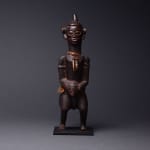Chokwe Wooden Sculpture of a Man, 19th Century CE - 20th Century CE
Wood
9.1 x 38.6 cm
3 5/8 x 15 1/4 in
3 5/8 x 15 1/4 in
PF.4704 (LSO)
Further images
This powerful yet compact sculpture was by a sculptor of the Chokwe group. It is an unorthodox representation, with very short legs, a curved rump, a long, powerful trunk, elongated...
This powerful yet compact sculpture was by a sculptor of the Chokwe group. It is an unorthodox representation, with very short legs, a curved rump, a long, powerful trunk, elongated arms and neck, and a small, rounded head with a horn-shaped eminence protruding from the apex in the manner of Songye pieces. The piece is notable for the fact that the figure is holding what appears to be a decapitated head in his hands, in front of his loins. The arms and neck are decorated with jewellery both carved and applied, and it evidently represents a wealthy and prestigious man. The patina is dark and even.
The Chokwe, or Tchokwe, are distributed across Angola, the DR of Congo and Zambia, and can trace their ancestry to the Lunda Empire of the 15th century, when a mass-migration occurred out of Lunda/Luba territory. The resulting kingdoms – including the Tchokwe, Luena, Songo, Ovimbundu and Imbagala – were all closely allied until the mid 19th century when the Tchokwe, following a great famine, migrated south. Their art and culture is thus distinctive compared to that of the other Lunda-descended tribes.
Society is governed by a God-King (Mwana Ngana), under whom men’s (Mugonge) and women’s (Ukule) societies control age classes and ensure social harmony. This system has resulted in a series of masks that are designed to defuse social tensions, celebrate important events (i.e. circumcisions), impose judiciary powers and promote fertility, health and well-being. The main mask forms for which the Tchokwe are known are the male Cihongo mask – which symbolises wealth, power and judicial authority – and the female Pwo mask, which is an embodiment of idealised femininity. Figures are restricted, usually, to representations of Tshibinda Ilunga, the mythical founder of the Chokwe, and queen figures. This piece is unusual in that it seems to represent a chief who has vanquished an enemy. While unusual for the Chokwe, this is a not uncommon theme for African art in general; similar pieces, celebrating imagined or real triumphs, are known from Benin, the Yoruba and various Grasslands groups, amongst others.
This is an impressive piece of African art.
The Chokwe, or Tchokwe, are distributed across Angola, the DR of Congo and Zambia, and can trace their ancestry to the Lunda Empire of the 15th century, when a mass-migration occurred out of Lunda/Luba territory. The resulting kingdoms – including the Tchokwe, Luena, Songo, Ovimbundu and Imbagala – were all closely allied until the mid 19th century when the Tchokwe, following a great famine, migrated south. Their art and culture is thus distinctive compared to that of the other Lunda-descended tribes.
Society is governed by a God-King (Mwana Ngana), under whom men’s (Mugonge) and women’s (Ukule) societies control age classes and ensure social harmony. This system has resulted in a series of masks that are designed to defuse social tensions, celebrate important events (i.e. circumcisions), impose judiciary powers and promote fertility, health and well-being. The main mask forms for which the Tchokwe are known are the male Cihongo mask – which symbolises wealth, power and judicial authority – and the female Pwo mask, which is an embodiment of idealised femininity. Figures are restricted, usually, to representations of Tshibinda Ilunga, the mythical founder of the Chokwe, and queen figures. This piece is unusual in that it seems to represent a chief who has vanquished an enemy. While unusual for the Chokwe, this is a not uncommon theme for African art in general; similar pieces, celebrating imagined or real triumphs, are known from Benin, the Yoruba and various Grasslands groups, amongst others.
This is an impressive piece of African art.









